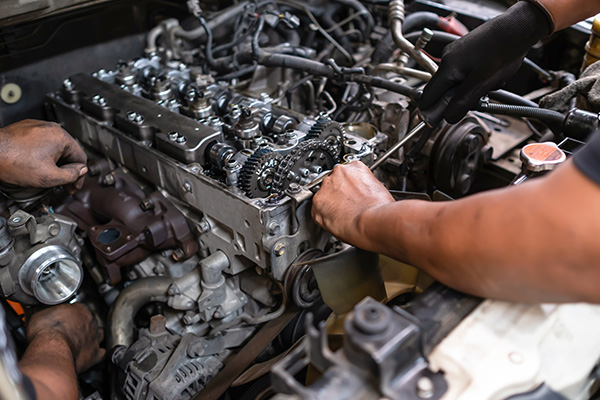
Putting off an oil change feels harmless at first. The engine sounds fine, the car still starts, and the dash is not yelling at you. The problem is that oil ages quietly. It loses the chemistry that protects metal parts, and contaminants begin to stack up inside the engine. Wait long enough, and what used to be a quick service turns into noisy start-ups, leaks, and expensive repairs you never planned for.
What Fresh Oil Actually Does Inside the Engine
Motor oil is more than a slick liquid. It forms a thin film that keeps metal parts from touching, carries heat away from the hottest zones, and suspends tiny particles so the filter can catch them. The additive package inside the oil does heavy lifting by neutralizing acids, preventing corrosion, and keeping varnish from sticking to passages. When that package is used up, the oil still looks like oil, but it cannot protect the way it did on day one.
Why Old Oil Breaks Down
Every heat cycle changes the oil a little. High temperature thins it, then cooling thickens it as oxidation byproducts form. Short trips add moisture and a touch of raw fuel that the oil must absorb. Detergents and dispersants get saturated with soot and metal fines. The result is oil that flows poorly on cold mornings and shears too thin once the engine is hot. That is when parts begin to wear faster, even if you do not hear a thing.
Early Warning Signs You Have Waited Too Long
Engines usually whisper before they shout. You might hear a light tick for a few seconds at startup that fades as the oil warms. The oil on the dipstick smells burnt or feels gritty between your fingers. The inside of the oil cap looks dark and sticky instead of lightly coated. In some cases, the idle feels rougher than it used to, or fuel economy slips a bit. These small hints show the oil is no longer doing its best work.
How Delayed Changes Create Sludge and Varnish
Sludge is the heavy, tar-like residue that builds when oil is left in service too long. It collects in low spots, clogs drain back holes in the cylinder head, and blocks small passages that feed timing components. Varnish is thinner but just as sneaky. It coats moving parts and makes variable valve timing react slowly. Once deposits form, fresh oil cannot wash them away quickly. That is why vehicles that have missed several intervals sometimes need a staged cleaning plan to recover.
Cold Starts Are Where Wear Adds Up Fast
Most engine wear happens in the first seconds after startup. Thick, tired oil moves slowly, so the upper valvetrain waits for protection while metal rubs on metal. You may notice a longer crank time or a louder first second as the pump fights to build pressure. In winter, this effect gets worse. Using the correct viscosity helps, but only if the oil is still fresh enough to meet the spec. Late changes take away that safety margin right when you need it most.
Gaskets, Seals, and Leaks After Long Intervals
Old oil is not kind to rubber. Oxidation and acid formation harden seals and shrink gaskets, which invite leaks around the valve covers, filter housing, or oil pan. Drivers sometimes think the leak caused the low level, when in reality, the overdue oil change helped create the leak in the first place. Fresh, correct spec oil keeps seals conditioned and slows aging. If a leak starts right after finally changing overdue oil, it is a sign that the seal was already brittle and now needs attention.
Turbocharged and Direct Injection Engines Are Less Forgiving
Modern turbo and direct injection engines run hotter and push oil harder than older designs. Turbos rely on oil for both cooling and lubrication. Old oil bakes into hard carbon around the turbo shaft after shutdown, which can lead to noise or failure. Direct injection allows a small amount of fuel to slip past rings during short trips, and that fuel dilutes the oil. These engines benefit from strict time-based intervals, even if you did not rack up many miles.
Simple Habits That Keep You on Track
You do not need an app to stay current, just a routine that sticks. Check the dipstick once a month on level ground with the engine cool. Write the date and mileage on a small label under the hood after each service. If most of your trips are ten minutes or less, use a time based interval such as every six months. If you tow, idle often, or drive in Texas heat, expect to service a little sooner than the longest interval in the manual. Consistency is what protects engines, not guesswork.
Oil Service Done Right at Kwik Kar Auto Repair on Belt Line in Richardson, TX
When it is time to catch up, Kwik Kar Auto Repair sets the correct oil and filter for your vehicle, checks for early leaks, verifies PCV operation, and looks for signs of varnish or sludge. We match the interval to your driving so you are not back too soon or waiting too long. If your engine has a turbo or direct injection, we follow the specifications that keep those systems healthy.
Schedule your oil service on Belt Line in Richardson today and keep your engine protected for the miles ahead.